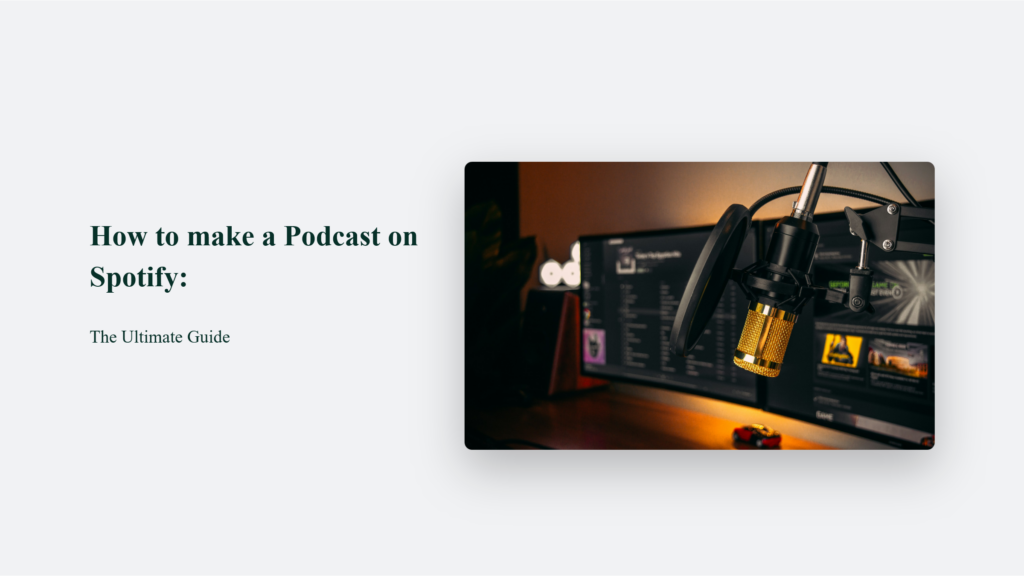![The ‘Giveaway Piggy Back Scam’ In Full Swing [2022]](https://www.cjco.com.au/wp-content/uploads/pexels-nataliya-vaitkevich-7172791-1-scaled-2-683x1024.jpg)

How to make a Podcast on Spotify: The Ultimate Guide

As Seen On
Creating a podcast on Spotify is like embarking on an exciting journey of self-expression and connection, reaching out to millions with your voice, stories, and insights. In this comprehensive guide, we’ll walk through the essential steps on how to make a podcast on Spotify and even dive into how to monetize your podcasting passion. Let’s unlock the potential of your voice on one of the world’s leading streaming platforms.

The Allure of Podcasting on Spotify
Imagine sharing your thoughts with a global audience, engaging in topics you’re passionate about, and even turning this passion into a potential income source. That’s the allure of podcasting on Spotify. Whether it’s the intimacy of storytelling, the thrill of engaging debates, or the joy of sharing music and culture, podcasts offer a unique way to connect.
How to Make a Podcast on Spotify: A Detailed Walkthrough
Embarking on the journey of podcast creation, especially on a platform as vast and influential as Spotify, is an exhilarating venture that blends creativity with technical savvy. Each step, from conceptualization to audience growth, involves meticulous planning and execution. Let’s delve deeper into each stage to ensure your podcast sees the light of day and captivates and grows its audience.
Step 1: Conceptualize and Create
The genesis of a compelling podcast lies in its concept. It is the stage where you ponder deeply about your interests, passions, and the unique angle you can bring to your chosen topic. It’s not just about what you want to say but how you want to say it that will set your podcast apart. The choice of format—be it interviews, storytelling, educational, or a mix—will significantly influence your content’s delivery and audience engagement.
Equally important at this stage is assembling the right tools for the job. High-quality recording equipment doesn’t have to break the bank, but investing in a decent microphone, reliable recording software, and good headphones or speakers for editing is crucial. These tools ensure that your audio matches your content’s quality, making your podcast more professional and enjoyable.
Step 2: Meet Spotify’s Requirements
Before you hit the upload button on Spotify, it’s essential to familiarize yourself with their podcast requirements to ensure a smooth approval process. Spotify emphasizes the importance of high-quality audio, specific artwork dimensions, and metadata accuracy. Ensuring your podcast files are in MP3 format, with clear and consistent audio, and that your artwork adheres to the specified dimensions will pave the way for a hassle-free upload process.
Step 3: Record Your First Episode
Recording your first episode is a milestone in your podcasting journey. This step is about bringing your concept to life, and while the desire for perfection is natural, focusing on authenticity and passion is more crucial. Engaging content, clear delivery, and a well-structured flow will keep your audience hooked. Post-recording and meticulous editing to remove unnecessary pauses, errors, or background noises will enhance your podcast’s quality.
Step 4: Choose a Podcast Host
Selecting the right podcast hosting service is vital, as Spotify requires your podcast to be hosted externally. Services like Libsyn, Buzzsprout, and Blubrry offer various features, including analytics, easy Spotify submission, and different pricing plans to suit your needs. Your choice should consider long-term scalability, reliability, and the specific features that align with your podcasting goals.
Step 5: Submit Your Podcast to Spotify
With your podcast polished and ready, the next step is to submit it to Spotify through your chosen hosting service. It typically involves providing your podcast’s RSS feed, a unique identifier that allows Spotify to fetch new episodes as you publish them automatically. This step is often straightforward, thanks to the integration between Spotify and many hosting platforms, simplifying the submission process.
Step 6: Promote and Grow Your Audience
The creation and upload of your podcast are just the beginning. Building and growing your audience is an ongoing effort that requires consistent promotion and engagement. Leveraging social media platforms, engaging with your listeners through comments or dedicated groups, and collaborating with other creators can significantly expand your reach. Regularly soliciting feedback and adapting your content based on listener preferences are key to keeping your audience engaged and growing.
Each of these steps represents a critical phase in Spotify’s podcasting process. While the technical aspects are important, the heart of a successful podcast lies in its ability to connect, entertain, and inform its audience. As you navigate through each stage, remember that consistency, quality, and engagement are your best tools for growth and success in podcasting.
Monetizing Your Podcast:

Monetizing your podcast on Spotify opens various avenues for generating revenue, offering flexibility and creativity in building an income stream from your content. Here’s a comprehensive breakdown of methods to consider:
Spotify-Specific Monetization Options
- Automated Ads: Spotify for Podcasters provides access to Automated Ads, where sponsor-read ads are inserted into your episodes, targeting your listeners through the Spotify Audience Network. This option is currently invite-only and available in select countries.
- Podcast Subscriptions: You can create subscriber-only episodes, offering exclusive content for a monthly fee. This direct support model allows creators to build a more intimate relationship with their audience by providing special perks and bonus content.
- Listener Support: This feature enables your most loyal fans to support your show through monthly donations. It’s a simple way for listeners to contribute directly to the content they love.
Broad Strategies for Monetization
Beyond Spotify’s specific features, there are several general strategies for podcast monetization:
- Sponsorship Deals: Partner with brands to run ads on your show. This traditional model can be highly lucrative, especially as your audience grows.
- Merchandise Sales: Selling show-themed merchandise like t-shirts or stickers can provide an additional revenue stream while also increasing your brand’s visibility.
- Premium Paid Content: Offer exclusive content behind a paywall. It can include ad-free episodes, bonus material, or early access to episodes.
- Tiered Premium Content: Create different subscription levels, offering more exclusive content or perks at higher tiers.
- Donations: Use platforms like Patreon to accept donations from listeners who wish to support your show financially.
- Affiliate Marketing: Promote products or services on your podcast and earn a commission for sales or actions taken through your unique affiliate link or code.
- YouTube Monetization: You can tap into another revenue source by uploading video or audio-only versions of your podcast to YouTube and enabling ads.
- Live Podcast Events: Host live shows and charge admission for an in-person experience. It can also be an opportunity for additional sponsorships and merchandise sales.
Each monetization strategy has its own set of benefits and can be tailored to fit the unique aspects of your podcast and audience. Implementing multiple strategies simultaneously can maximize your earning potential. Remember, the key to successful monetization is providing value to your listeners, ensuring that monetization efforts enhance rather than detract from their experience.
The Bottom Line:
Embarking on your podcasting journey on Spotify is an exciting endeavour. With the right preparation, engagement strategy, and creativity, you can connect with listeners worldwide and potentially turn your passion into profit.
Gracie Jones
Up until working with Casey, we had only had poor to mediocre experiences outsourcing work to agencies. Casey & the team at CJ&CO are the exception to the rule.
Communication was beyond great, his understanding of our vision was phenomenal, and instead of needing babysitting like the other agencies we worked with, he was not only completely dependable but also gave us sound suggestions on how to get better results, at the risk of us not needing him for the initial job we requested (absolute gem).
This has truly been the first time we worked with someone outside of our business that quickly grasped our vision, and that I could completely forget about and would still deliver above expectations.
I honestly can’t wait to work in many more projects together!
Disclaimer
*The information this blog provides is for general informational purposes only and is not intended as financial or professional advice. The information may not reflect current developments and may be changed or updated without notice. Any opinions expressed on this blog are the author’s own and do not necessarily reflect the views of the author’s employer or any other organization. You should not act or rely on any information contained in this blog without first seeking the advice of a professional. No representation or warranty, express or implied, is made as to the accuracy or completeness of the information contained in this blog. The author and affiliated parties assume no liability for any errors or omissions.

